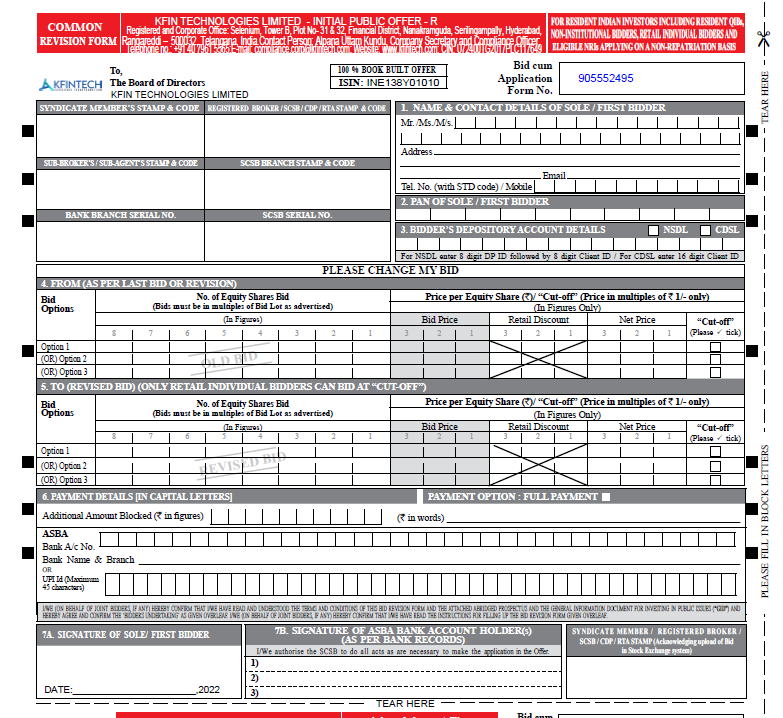SME IPO Consultant
View Chapters
Content:
Once an investor has applied for an IPO, there may be scenarios when the investor may want to change the bid quantity or bid price to increase their chances of allotment based on the IPO demand. Sometimes, it may also happen so that the investor may think that the IPO is not right and would like to cancel and withdraw their bid.
The IPO cancellation and modification facility helps investors to make these desired changes.
However, there are certain rules and restrictions for cancellation and modification of the IPO.
Rules for IPO application cancellation/modification by issue type
Mainboard IPOs
- Only Retail Investors (RIIs) are allowed to cancel their IPO bids.
- QIBs and NIIs cannot cancel once placed.
- Retail investors may modify their bids to increase or reduce the size of their application.
- QIBs and NIIs can only increase their bid, not reduce.
- Modifications and cancellations are allowed anytime while the IPO is open for subscription.
- No changes are allowed during the post-issue modification period.
SME IPOs
- The rules may vary depending on the offer document (RHP).
- In some SME IPOs, Individual Investors are permitted to cancel or revise bids like mainboard RIIs.
- In others, cancellation/withdrawal is not permitted, and only upward revision (similar to QIBs and NIIs) is allowed.
Rules for IPO application cancellation/modification by investor category
Mainboard IPO Bid Cancellation Rule |
Mainboard IPO Bid Modification Rule |
SME IPO Bid Update Rule |
|
|---|---|---|---|
Retail/Individual Investors |
Bid can be cancelled. |
Bid size can be increased or decreased. |
Minimum application is 2 lots. (Note: In some SME IPOs, cancellation/withdrawal is not permitted; only upward revision may be allowed, subject to RHP.) |
Bid cannot be cancelled. |
Can only increase the bid quantity or price but cannot lower it. |
Same as mainboard – only upward revision permitted. |
|
|
Bid cannot be cancelled. |
Can only increase the bid quantity or price but cannot lower it. |
Same as mainboard – only upward revision permitted. |
|
|
Bid can be cancelled if the bid size is lower than Rs 2 lakhs. |
Bid size can be increased or decreased if the bid size is lower than Rs 2 lakhs. |
Minimum application is 2 lots. Bid size can be revised up to the employee max lot limit, with cancellation/revision rules subject to RHP. |
|
|
Bid can be cancelled if the bid size is lower than Rs 2 lakhs. |
Bid size can be increased or decreased if the bid size is lower than Rs 2 lakhs. |
Minimum application is 2 lots. Bid size can be revised up to the shareholder max lot limit, with cancellation/revision rules subject to RHP. |
Note: The above cancellations and modifications are permitted anytime while the IPO is open for subscription.
IPO Application Cancellation Process
Investors can cancel/delete the IPO application online/offline. Online cancellation is much faster than offline cancellation. However, the option to cancel/withdraw/delete the IPO request is available only after the order has been submitted to the Exchange.
Steps for online withdrawal of IPO application
- Log in to the broker platform/Net banking from where investors have applied for the IPO.
- Go to the IPO tab.
- Open the IPO applied for that needs to be cancelled.
- Click on 'Cancel/Delete/Withdraw Bid/Application'.
- Confirm the transaction.
- Revoke the UPI mandate (if required).
Note: In case of UPI IPO application, sometimes it is required to revoke the mandate. In some cases, the bank will refund the amount after the UPI mandate expires. Investors must check with the bank for the UPI-specific procedure in advance.
The broker submits the cancellation request to the Exchange between 10 am and 5 pm. The broker updates the status of the cancellation request as soon as it receives confirmation from the exchange. Investors receive an email notification when the request is cancelled.
Note: The above is a generic process and will differ a bit for every broker/bank.
Steps for offline IPO order cancellation
- Prepare a cancellation letter with below details:
- IPO application No.
- Applicant Name and Application Details.
- PAN No.
- Sign the letter.
- Submit the letter to the intermediary through whom the application was submitted.
IPO Application Cancellation Time
Investors can withdraw from an IPO anytime while the IPO is open for subscription. The exchange IPO bidding window is open from 10 AM of the issue open date to 5 PM of the issue closure date. Investors can cancel an IPO anytime during this bidding window.
Some brokers may have set a specific time for cancellation. On the last day, many banks and brokers have a specific deadline for submitting cancellation requests to avoid last-minute problems. Therefore, it is important for investors to check with their broker/bank in advance for the exact deadlines for canceling the IPO applications.
Important note: The online "Cancel/Withdraw" option is only visible if the IPO application has been successfully submitted. If the investors do not see the cancellation option online, contact the bank or broker through whom the application for the IPO was submitted.
IPO withdrawal time : 10 AM of IPO open date to 5 PM of IPO closure date.
Investors can cancel an IPO at any time during this window.
Note:
- On the last date, not all banks/brokers may allow cancellation till 5PM. They could close the window a little earlier to process the requests.
- Some brokers have specific time allotted for cancellation and modification requests.
There are no cancellation fees charged by a bank or broker for withdrawing a bid either online or offline from an IPO.
For eg: Zerodha allows to place cancellation and modification requests between 10 AM to 4.30 PM when the IPO is open for subscription.
2. IPO Application Modification Process
An investor has the option to amend their IPO bid if they wish to change the bid amount or quantity. Retail investors may adjust their bids by either upsizing or downsizing their bids. QIBs and NIIs are allowed only to upsize their bids i.e. they can only change to increase the bid quantity or bid price.
Like cancellation, investors can modify the IPO requests anytime while the IPO is open for subscription. Though the IPO window is open from 10 AM of the issue open date to 5 PM of issue close date, the investors should check with their broker/ bank for any specific timings for modification request submissions; especially for the last day as not all banks/brokers allow modification till 5 PM.
You can modify IPO bids either online or offline. The option to modify online is visible once the bid is submitted to exchange.
Generally, SME IPOs also follow the same cancellation and modification rules as mainboard IPOs. However, in certain cases the rules may differ — for example, some SME IPOs may restrict cancellations and allow only upward revisions. Investors should always check the specific SME IPO offer document (RHP) for final clarity.
Steps to modify IPO bid online:
- Login to the broker platform or Net banking account.
- Go to the IPO section.
- Select the applied IPO.
- Click on Modify Bid.
- Modify the Bid quantity or bid price.
- Click on Confirm/Update.
- Approve the revised UPI mandate. In case of ASBA application, the additional amount gets blocked in case of upward revision. In case of a downward revision, the amount gets unblocked post allotment.
Steps to modify IPO bid offline :
- Procure the IPO modification/revision form from the nearest broker/bank or download it from the exchange website.
- Fill the form with personal details like Name, Address, Contact Details, Email, PAN, and DP details.
- Enter the old bid data and the updated bid data.
- Enter the ASBA account number/ UPI ID.
- Sign the form.
- Submit the form to the intermediary through whom the original application was made.
IPO Modification Form
Investors can download the IPO revision form from the BSE or NSE website.
The NSE offers investors the option of downloading either a blank revision form or a pre-filled form. For more details on the IPO application form, please refer to the IPO Application process Chapter.
Sample IPO Modification or Revision Form

IPO Application Rejection Reasons
While submitting an IPO application, investors must follow certain points for the application to be valid, failing which the application may get rejected. There are several reasons why an IPO application may be rejected. The rejection can be on account of error by the applicant, bank or another intermediary, or due to technical problems.
The following are some of the most common reasons for the rejection of an IPO application:
- Application by an incompetent applicant under the terms and conditions of the company or under the Indian Contract Act 1872.
- The bid price is outside the price band.
- Incorrect ASBA account number / UPI ID / UPI handle.
- Application from another person’s bank account.
- Incorrect PAN or DP details.
- Mismatch in applicant name, name on DP account, and bank account or PAN.
- Bidding for an amount lower than the minimum bid size.
- Multiple applications using the same PAN in the same investor category.
- Bidding at cut-off price by NII or QIB and individual investors (in case of SME IPO).
- Insufficient funds in the bank account.
- Errors on part of the intermediaries.
IPO application rejected but amount blocked
Investors receive the blocked amount if their request is rejected after the mandate date.
Some banks may not refund until the mandate expires. In such cases, investors can ask the bank or intermediary whether the funds will be released after the allotment date.
Page Glossary:
1. UPI handle
UPI handle is the bank name or the payment application name that processes the UPI payment. It is the virtual payment address used for making payment via the UPI gateway.
UPI handle starts with @ and is different for every UPI mobile application. For example if the UPI payment is used making the Paytm app, the UPI handle for the said app is @paytm. Refer to the list of mobile applications for making UPI payment with the details of their UPI handle.
2. DP ID
DP ID stands for " Depository Participant Identification". A Depository Participant, such as a bank, financial institution or brokerage firm, is assigned a DP ID number by NSDL and CDSL. DP ID varies depending on the depository institution where you have your account. The investor's demat account number is composed of the customer number ID and the Depository participant number DP ID.


